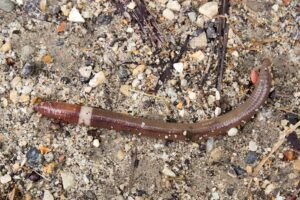Asian Jumping Worms: Preventing Their Spread in Plant Sales
Asian Jumping Worms (AJW) have been identified in Indiana! Southern Indiana has the highest documented population, but they have been found in several counties across the state, including Marion, Lake, and Porter.
These non-native, highly invasive earthworms live in shallow layers of organic soil and mulch, where they quickly digest organic matter and replace it with their castings (worm poop), in which all nutrients are bound up and made unavailable to plants. This new top layer is said to look like large coffee grounds. With nutrients no longer available, seed germination or plant development is greatly impaired. In the long term, this creates an environment that is more vulnerable to invasive plant establishment and reduced native plant vigor.
As we move into spring plant sale season, we gardeners must be cognizant of this new threat to healthy ecosystems. These worms do not travel on their own capabilities but are spread predominantly through human interactions: through the transfer of soil, amendments, and plant roots. Researchers are working on best practice recommendations to slow or eliminate the spread of the AJW. As we look to our gardens to divide plants to share for plant sales, here are some important guidelines:
Scout for Asian Jumping Worms in your garden:
- Learn to identify the worm. These worms are similar to our common earthworms but are are more gray and brown and less pink. Their clitellum, the band of lighter-colored tissue near the head is smooth, not raised like other earthworms and whitish, not pink. They don’t produce slime and tend to be drier than common earthworms and scaly. Their bodies are firmer, giving them the ability to thrash around a lot when agitated. They sometimes release the tail end of their body as a defense mechanism. (See the resource links below for more identification tips).
- Conduct a mustard test. Using a liquid “mustard pour” is a way to test for jumping worms. Mix ⅓ cup of hot mustard powder into 1 gallon of water and pour half of the liquid slowly over a 1 square foot of soil you want to test. Wait a few minutes and pour the rest. This will make any worms) come to the surface. Identify, collect, and discard jumping worms, if present. The mustard solution will not harm plants or kill the worms. (Excerpt from University of Wisconsin, cited below. They were first detected in Wisconsin in 2013). REMEMBER: This is a test for adult worms but does not aid in the detection of eggs and cocoons.
You may not be aware of the presence of AJW in your soil, but that does not mean they are not present. So, when potting up plants to share, you must take measures to prevent any possible spread of the worms, their eggs or cocoons. The eggs and cocoons are microscopic (soil particle sized) and not normally distinguishable to the human eye. Adults are most visible from June throughout the summer.
Prepare to safely share your plant divisions:
- Bare-root your divisions: When dividing your plants, knock off the soil adhering to the roots. Then place the divisions in a bucket of water and continue to rinse until all soil is removed. If AJW have been detected on your property, cover the bucket with a disposable paint filter* before pouring out the water. This will capture and kill any worms that might be present, and you can dispose of them in the garbage.
- Pot them up in a sterile potting medium: Once thoroughly bare-rooted, pot the plants into a sterile potting medium. Make sure pots are clean of soil and any possible cocoons. If practical, a soilless medium is safest. Otherwise, be sure to use a trusted source of soil and compost. Ask your local dealers what they know about the prevention of transporting the Asian Jumping Worm in their products. For more detailed instructions see this publication from University of New Hampshire Extension: https://extension.unh.edu/resource/plant-sales-and-jumping-worms .
- Store your potted divisions on a platform: The safest method for storing your potted plants is on a sealed surface, or some platform at least 16” elevated above soil.
Questions? Contact Bob Bruner, Exotic Forest Pest Educator at Purdue Extension: rfbruner@purdue.edu
Resources
https://extension.umd.edu/resource/invasive-jumping-worms
https://extension.unh.edu/sites/default/files/migrated_unmanaged_files/Resource007945_Rep11616.pdf
https://extension.unh.edu/blog/2018/03/invasive-spotlight-jumping-worms

